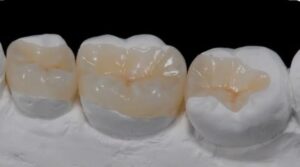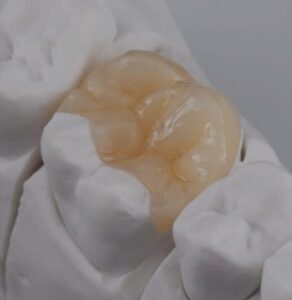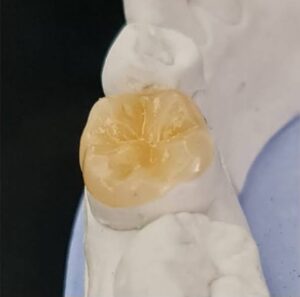
Dental Inlays, Onlays, Tabletops/Overlays, EndoCrowns & Vonlays
All together, dental inlays, onlays, tabletops/overlays, endocrowns, and vonlays provide comprehensive solutions for restoring teeth with varying degrees of damage or decay.
All of these are categorically part of bonded dentistry. When crowning and orthodontic treatment are not possible, the ceramic restorations fabricated in laboratories are bonded onto your teeth, where there has been a loss of your tooth structure.
Dental restorations are custom-made solutions used to repair damaged or decayed teeth. Among the various types of restorations, dental inlays, onlays, Vonlays, tabletops, and overlays are popular options. In this article, we’ll delve into each of these restorations, exploring their characteristics, benefits, and differences.
Inlays
Dental inlays are customized fillings used to repair teeth with moderate decay or damage. Made from materials like gold, porcelain, or composite resin, inlays are bonded to the tooth using a special adhesive. They are ideal for teeth that require more support than a traditional filling but less than a crown.
Indications for Inlays:
- Extensively restored or weakened teeth
- Repeated fracture or failure of previous direct restoration
- Restorations within body of tooth which do not require cuspal coverage
- Endodontically treated teeth in which the cavity has compromised strength and prognosis.
Onlays

A dental onlay, also known as a partial crown, is a restoration that covers only a portion of the tooth. Onlays are used to repair teeth with more extensive damage, such as cracks or fractures. They are typically made from materials like porcelain, ceramic, or gold.
Indications for Onlays:
- Moderate to severe decay in a tooth.
- Fractures or cracks in a tooth that affect more than just the biting surface.
- When cusps are damaged but the tooth root and structure remain largely intact.
- Restoration of teeth in areas that require additional strength, such as molars.
Overlays / TableTops

The term “Dental Overlays/TableTops” is used interchangeably. Although there is slight variation in the preparation of the tooth. They are indicated where crowns cannot be given & complete cuspal coverage of biting surfaces is recommended, eg. Root Canal treated teeth.
Dental overlays are thin, custom-made restorations used to cover the chewing surface of a tooth. They are typically made from materials like porcelain or composite resin. Overlays are used to repair teeth with minor damage or decay. Dental overlays can last anywhere from 5 to 15 years or more.
With proper care and maintenance, overlays can provide long-lasting restoration of damaged or weakened teeth, which improves both function and aesthetics for many years.
These are nothing but overlays/tabletops where post root canal filling is also part of this restoration. These are recommended after root canal treatment, as the name suggests.
 Vonlays
VonlaysWhere there is dental veneer recommended and also a dental filling on the biting surface of the tooth is to be given. This option is considered where both the fillings come together as a unit fabricated from the laboratory.
In conclusion, dental inlays, onlays, Vonlays, tabletops, and overlays are all effective solutions for restoring damaged teeth. Each type of restoration has its own unique characteristics, benefits, and applications. By consulting with a dentist, patients can determine the best course of treatment for their specific needs.
